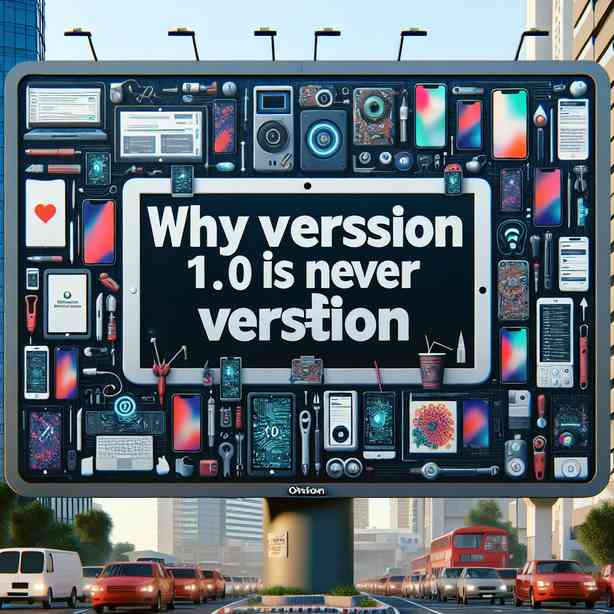
In the rapidly evolving landscape of technology, software development, and product design, it’s a well-accepted notion that Version 1.0 is rarely the final iteration. Instead, it marks the beginning of a journey filled with continuous improvement, user feedback, and evolving needs. This phenomenon can be attributed to several factors, including user feedback, emerging technologies, market competition, and the need for adaptability in an ever-changing environment.
When a product first launches, it is often a reflection of the ideas and assumptions made during its development. It serves as an initial response to a perceived need in the market. However, the real test begins after the launch. Users start interacting with the product, and their experiences can be vastly different from what the creators envisioned. Their feedback becomes invaluable, as it highlights areas for improvement, reveals unexpected challenges, and even uncovers new features that could enhance the user experience. This iterative process is crucial, as it aligns the product closer to the actual needs and wants of its users.
Furthermore, technology does not exist in a vacuum. New advancements emerge at an incredible pace, giving rise to features and functionalities that were previously unimaginable. A product that is deemed satisfactory today may soon fall behind as new technologies and methodologies change the landscape. For instance, consider how mobile applications have transformed dramatically since their inception. Early versions were often limited in scope and functionality, but as users embraced smartphones, developers had to adapt and innovate rapidly, resulting in a plethora of features and capabilities that we now take for granted.
Market competition also plays a significant role in driving the evolution of a product. Once a product is released, it enters a competitive arena where other companies are simultaneously attempting to capture the same audience. This competitive environment necessitates that companies stay vigilant and be ready to iterate on their offerings. A product that remains static may quickly lose its relevance as competitors introduce new features, improved user experiences, or innovative solutions. Thus, the need for constant evolution is not just desirable; it is essential for survival in a competitive market.
Adaptability is another cornerstone in the journey after Version 1.0. The needs of users can shift rapidly due to changing societal norms, economic conditions, or even global events. The COVID-19 pandemic, for instance, shifted numerous operational paradigms for many companies, making it essential to adopt flexible strategies that cater to emerging demands. A product that can evolve in response to such changes is much more likely to thrive over time. This adaptability may involve rethinking user interfaces, exploring new markets, or incorporating features that reflect the changing landscape in which the product exists.
In addition, Version 1.0 often carries with it initial growing pains. Bugs, usability issues, and unforeseen consequences can hinder the user experience. These growing pains offer critical learning opportunities, as they can reveal underlying assumptions that may have been overlooked during development. By addressing these issues in subsequent updates, developers can enhance not just the product itself but also build trust and reliability with their user base. Users frequently appreciate transparency regarding updates and improvements; it fosters a sense of community and loyalty when they know their feedback is being acted upon.
Moreover, the feedback loop between developers and users often becomes a powerful catalyst for innovation. By actively engaging with users through surveys, beta testing, and feedback forums, companies can gather insights that may not have been considered initially. These insights can lead to breakthrough features or enhancements that set the product apart from its competitors. Often, the most successful iterations stem from ideas generated through active user engagement, showcasing the importance of keeping communication channels open and responsive.
It is also important to recognize that launching Version 1.0 can create a momentum that propels further development. The act of putting a product into the market allows companies to gain traction, generate buzz, and build a user community. This community can then become a valuable asset, providing real-world use cases, testimonials, and advocacy that can be leveraged in marketing efforts. As the product continues to evolve, this user base can serve as a sounding board for new ideas and directions, creating a symbiotic relationship that benefits both the company and its users.
The path from Version 1.0 to subsequent iterations is not always linear; there will be bumps along the way. Sometimes, a particular feature may need to be rolled back due to negative user feedback, or a shift in market trends may require a complete overhaul of functionalities. These setbacks, however, can often lead to unexpected breakthroughs in creativity and design. Constructive criticism and the willingness to pivot can yield greater alignment with user needs, ultimately resulting in a better final product.
Lastly, it is crucial to emphasize the concept of embracing a growth mindset. The process of refining and evolving a product is not solely about fixing mistakes or responding to negative feedback. It is an opportunity for continuous learning and innovation. By viewing each version as a stepping stone towards excellence, teams can cultivate an environment that encourages experimentation and creativity. This growth mindset not only benefits the product but also enhances team morale and fosters a culture of collaboration.
In conclusion, Version 1.0 should be seen as the beginning of an exciting journey rather than the end of a project. It is a chance to learn, adapt, and innovate based on user interactions and emerging technologies. By embracing this iterative approach, companies can navigate the complexities of the market, respond to user feedback, and foster an environment of continuous improvement. The ultimate goal is not to create a perfect product in isolation but to develop a solution that evolves alongside its users and their changing needs, ensuring relevance and longevity in a dynamic world. By doing so, businesses can position themselves not just to survive but to thrive in the face of ever-changing challenges and opportunities.


